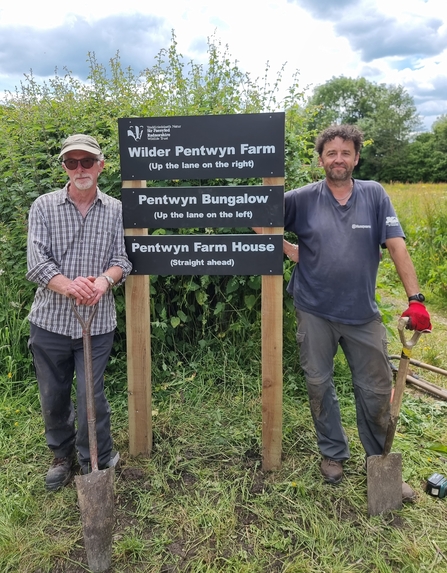It's been a year since Chloe, the Pentwyn Project Officer, asked if I’d take on the volunteer warden role at Pentwyn. At that point, I didn’t really know what to expect. I had been working for a few months with the Trust’s long-established Tuesday Volunteer Group and had learned a lot about the work they do across the different reserves, but Pentwyn was going to be different. As a showcase for how conservation and biodiversity programmes can fit alongside efficient farming practices and evolving land use, Wilder Pentwyn involves a wide variety of initiatives. Looking back over the year, it’s amazing just how much has been done.
©Paul Blair
My main role as a volunteer warden is to help the Trust’s staff protect and improve the reserve. At Pentwyn, this involves regular walks around the 164-acre site, checking for any issues with fencing, for example, or with the free-grazing cattle, ponies and pigs. Walking over Pentwyn is always a pleasure and there is usually something interesting to see – a kestrel hovering around Cnwch Bank, a hare bounding away over a hill, a roe deer disappearing into Fiddler’s Plantation, or five-spot burnet moths flittering around a field. At the same time, I might pick up some old Barbed Wire that needs clearing away, stand up a fallen gate, or note any sheep incursions. The ponies and pigs occasionally come up for a stroke or a scratch, though the Belted Galloways are much shier. I’ll usually send Dale, the grazier, a quick message to let him know all is fine with the stock.
Bigger maintenance and improvement tasks call for more hands. It’s been fun to work with the Tuesday Volunteer Group and the local Pentwyn volunteer group on tasks like tree & hedge planting, fencing, coppicing, hay spreading, and installing new signage.

Connecting with the local community is another important aspect of the Wilder Pentwyn project. I’ve enjoyed helping Chloe and other RWT staff at many of the events held at Pentwyn over the year. These have included fungi, botany and wildlife talks, a bat survey, an astronomy evening, a woodland management event, and a public walk to the source of the Lugg. It is rewarding to see how these events have engaged members of the public and local landowners.
Another rewarding task has been helping with the various wildlife and habitat surveys at Pentwyn. The Winter Bird Survey and the Breeding Bird Survey have been a particular focus for me, working with Martyn, Alan and Ben. Together, we have completed a full set of monthly bird surveys over the last 10 months. At present over 70 bird species have been recorded at Pentwyn, a number we expect to see increase. I also had the chance to contribute to surveys for bees, moths, and butterflies. It was fascinating to join the botany surveys as well, which will provide a benchmark for the creation of flower-rich hay meadows in future. The surveys are an excellent opportunity to learn from experts and other volunteers. I’ve definitely improved my identification skills! As a result of all this work, we are building a detailed baseline picture of Pentwyn. This data will enable an accurate assessment of how various initiatives are affecting the diversity of plants and wildlife across the farm.
In his recent book, Tir, Carwyn Graves describes the complex interplay between habitat, wildlife, farming and community that have shaped the Welsh landscape over many centuries. He argues that a recognition of these connections must be at the heart of initiatives to address the climate crisis and a loss of biodiversity. I believe that the work being done at Pentwyn is an excellent example of that approach.
As we plan for the next year at Pentwyn, I’m excited to see the results of our efforts so far and of new initiatives such as the proposed wetland area. It is a privilege to be able to play a small part in such an important project at this critical time.
Written by Eric Woods


